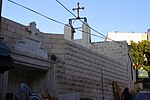The Battle of Tulkarm took place on 19 September 1918, beginning of the Battle of Sharon, which along with the Battle of Nablus formed the set piece Battle of Megiddo fought between 19 and 25 September in the last months of the Sinai and Palestine Campaign of the First World War. During the infantry phase of the Battle of Sharon the British Empire 60th Division, XXI Corps attacked and captured the section of the front line nearest the Mediterranean coast under cover of an intense artillery barrage including a creeping barrage and naval gunfire. This Egyptian Expeditionary Force (EEF) victory over the entrenched Ottoman Eighth Army, composed of German and Ottoman soldiers, began the Final Offensive, ultimately resulting in the destruction of the equivalent of one Ottoman army, the retreat of what remained of two others, and the capture of many thousands of prisoners and many miles of territory from the Judean Hills to the border of modern-day Turkey. After the end of the battle of Megiddo, the Desert Mounted Corps pursued the retreating soldiers to Damascus, six days later. By the time an Armistice of Mudros was signed between the Allies and the Ottoman Empire five weeks later, Aleppo had been captured.
During the Battle of Tulkarm the 60th Division, (XXI Corps) advanced to cut the front line Ottoman trenches. They were supported as they moved forward by artillery fire, which lifted and crept forward while the infantry advanced to capture Nahr el Faliq. Their advance forced the Ottoman Eighth Army to withdraw, and the continuing attack resulted in the capture of Tulkarm, and the Eighth Army headquarters. The tactic of the infantry attack covered by creeping artillery fire, was so successful that the front line was quickly cut and the way cleared for the British Empire cavalry divisions of Desert Mounted Corps to advance northwards up the Plain of Sharon. The cavalry aimed to capture the Ottoman lines of communication in the rear of the two German and Ottoman armies being attacked in the Judean Hills. By 20 September these cavalry divisions reached the rear, completely outflanked and almost encircled the Ottoman Seventh and Eighth Armies during the Battle of Nazareth, Capture of Afulah and Beisan, Capture of Jenin and Battle of Samakh. Meanwhile, British Empire infantry divisions on the right of the 60th Division advanced to successfully attack the German and Ottoman trench lines along their front line at the Battles of Tabsor and Arara. The Ottoman Seventh Army headquarters at Nablus was subsequently attacked and captured during the Battle of Nablus.










